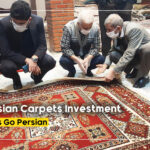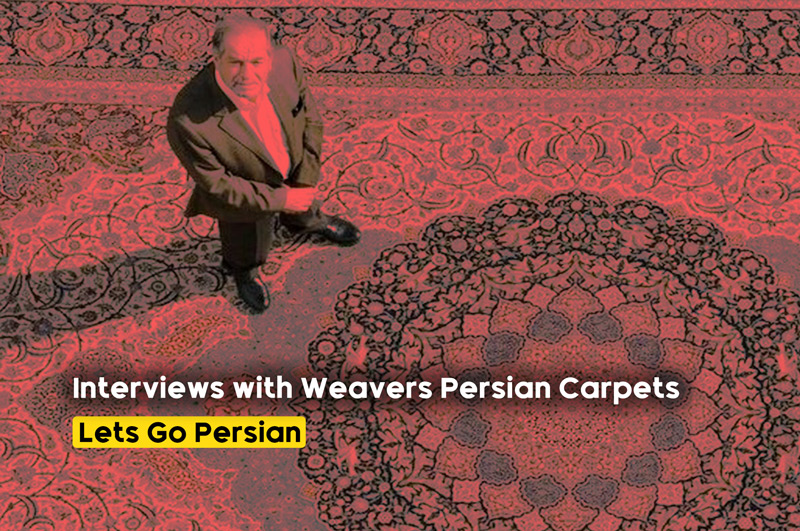
Persian Carpets as an Artistic and Financial Investment

Exploring Modern Designs in Contemporary Persian Carpets
The art of weaving Persian carpets is a tradition that spans centuries, passed down through generations of skilled artisans. These weavers and artists are the lifeblood of an ancient craft that continues to captivate the world with its intricate designs, fine craftsmanship, and cultural significance. To truly appreciate Persian carpets, it’s important to hear the stories of those who dedicate their lives to this art form. In this post, we explore interviews with some of the most prominent weavers and artists of Persian carpets, uncovering their inspirations, challenges, and the future of this treasured art.

Interviews with Prominent Weavers and Artists of Persian Carpets
1. Master Weaver Ali Rezaei: Preserving Tradition in a Modern World
Ali Rezaei is one of the most respected master weavers in the Tabriz region, known for his detailed work on carpets that feature both traditional and modern designs. Rezaei’s workshop continues a long family legacy, where each member of his family has played a role in keeping the art of weaving alive.
Interview Excerpts
Q: How did you get started in carpet weaving, and what inspires your designs?
Ali Rezaei:
“Carpet weaving runs in my family. I began learning the craft when I was just eight years old, watching my father at the loom. Over the years, I’ve drawn inspiration from the beautiful architecture of Tabriz and the natural landscapes that surround us. Our carpets often incorporate geometric patterns and medallions, but I like to include subtle modern elements in some of my designs to attract younger collectors.”
Q: How do you balance tradition with innovation in your work?
Ali Rezaei:
“Maintaining tradition is essential for me, but we can’t ignore the changing tastes of the modern world. While our core designs stay true to Persian roots, I experiment with color palettes and abstract patterns to give my pieces a contemporary feel. This approach keeps the tradition alive while also making it relevant for today’s buyers.”
Q: What challenges do you face as a weaver in today’s market?
Ali Rezaei:
“One of the biggest challenges is the influx of machine-made carpets flooding the market. These carpets are much cheaper, and many people can’t tell the difference. It affects the livelihood of artisans who pour their heart and soul into hand-weaving. Educating buyers about the value of handmade carpets is crucial.”
2. Mahin Tabrizi: A Pioneer of Contemporary Persian Carpet Art
Mahin Tabrizi is an artist and weaver based in Isfahan, known for her innovative use of colors and abstract designs that challenge traditional perceptions of Persian carpets. Tabrizi’s work blends modern art with classic Persian weaving techniques, positioning her as a pioneer of contemporary Persian carpets.
Interview Excerpts
Q: What drew you to the art of carpet weaving, and how did you develop your unique style?
Mahin Tabrizi:
“I was always drawn to color and texture. I grew up in a home surrounded by Persian carpets, but I wanted to approach the art differently. After studying fine arts, I realized that Persian carpets could be a canvas for contemporary expression. My designs are less about traditional motifs and more about abstract shapes and modern interpretations of classic patterns.”
Q: How do you incorporate modern artistic techniques into a centuries-old tradition?
Mahin Tabrizi:
“While I respect traditional techniques, I believe that the art of weaving can evolve. I use bold colors and unconventional patterns that often challenge the viewer’s perception of what a Persian carpet should be. By blending traditional weaving techniques with modern concepts, I’m creating something that bridges past and present.”
Q: What message do you want to convey through your carpets?
Mahin Tabrizi:
“My carpets are meant to evoke emotion. I want people to feel something when they see the interplay of colors and shapes. Persian carpets have always told stories, and I want my designs to tell a story of modernity, evolution, and innovation, while still honoring the craftsmanship that makes them so valuable.”
3. Farzaneh Etemadi: A Defender of Persian Carpet Weaving Heritage
Farzaneh Etemadi is an award-winning weaver and cultural advocate from Kashan, a region famous for producing some of the finest Persian carpets. Etemadi is deeply committed to preserving the traditional art of carpet weaving and has become a voice for female artisans in Iran.
Interview Excerpts
Q: What inspired you to become a weaver, and how do you see your role in preserving Persian carpet heritage?
Farzaneh Etemadi:
“I was inspired by the women in my family, especially my mother, who was a master weaver. I learned from her, not just the technique but the passion that goes into weaving. Carpet weaving is part of Kashan’s identity, and I feel it is my duty to ensure that this craft continues. Our carpets are known for their fine wool and elegant floral designs, and I want future generations to experience this beauty.”
Q: How are you supporting female artisans in your region?
Farzaneh Etemadi:
“Many of the weavers in Kashan are women, and they often face economic and social challenges. I have been working with local organizations to create workshops and cooperatives that empower these women by giving them a platform to sell their work directly. Through this effort, we’re not just preserving the craft—we’re also ensuring the economic independence of the women who carry on this tradition.”
Q: What are your hopes for the future of Persian carpet weaving?
Farzaneh Etemadi:
“I hope we can maintain the integrity of our craft in the face of modern challenges. I see more young people taking an interest in weaving, and that gives me hope. It’s important to innovate, but we must also remain true to our roots. Persian carpets are not just rugs—they are part of who we are.”
4. Hossein Zand: A Collector’s Perspective on Persian Carpets
Hossein Zand is a renowned Persian carpet collector and scholar who has spent decades studying the historical and cultural significance of Persian carpets. Zand is a frequent speaker at international carpet exhibitions and has worked with museums to showcase some of the finest antique Persian carpets in the world.
Interview Excerpts
Q: What is it about Persian carpets that makes them so special to you?
Hossein Zand:
“Persian carpets are the perfect combination of art, culture, and utility. They carry centuries of history, and each carpet tells a story. The level of detail and craftsmanship is unmatched, and what I find most special is how these carpets remain relevant today. They connect the past with the present in a way that few art forms can.”
Q: What advice would you give to someone interested in collecting Persian carpets?
Hossein Zand:
“My first piece of advice is to educate yourself. Learn about the different regions, the designs, and the materials used. Don’t be swayed by cheap imitations. An authentic Persian carpet is a work of art, and you should treat it as such. Look for carpets that speak to you, whether it’s through their design, color, or historical significance. A good carpet is an investment that will appreciate over time.”
Q: How do you see the future of Persian carpet collecting?
Hossein Zand:
“I believe that Persian carpets will continue to be highly sought after, especially as more people understand their cultural significance. However, I worry that mass production and machine-made imitations could dilute the market. It’s crucial for collectors to support authentic Persian carpets and the artisans who make them. If we continue to value quality and craftsmanship, Persian carpets will remain timeless treasures.”
5. Parviz Jalali: A Visionary in Sustainable Carpet Weaving
Parviz Jalali is a weaver and environmental advocate from Qom, a city known for its delicate silk carpets. Jalali has become a key figure in promoting sustainable weaving practices, using environmentally friendly materials and dyes in his carpet-making process.
Interview Excerpts
Q: What motivated you to focus on sustainability in carpet weaving?
Parviz Jalali:
“I’ve always felt that we need to be more mindful of the environmental impact of our work. Persian carpet weaving is an ancient art, but that doesn’t mean we can’t evolve with the times. I began experimenting with natural dyes and organic materials, not just to create beautiful carpets but to also reduce our ecological footprint. Sustainability is a core part of my philosophy.”
Q: How do traditional techniques blend with your sustainable practices?
Parviz Jalali:
“Traditional Persian carpets have always used natural materials like wool, silk, and natural dyes. What I’m doing is simply returning to these methods in a more focused way. For example, I source my wool from local shepherds who practice sustainable farming, and I use plant-based dyes that are not harmful to the environment. This approach enhances the quality of the carpets and ensures that they are eco-friendly.”
Q: Do you think sustainability will become a larger part of Persian carpet weaving in the future?
Parviz Jalali:
“Absolutely. More and more consumers are looking for ethically made products, and that includes Persian carpets. We need to show that traditional arts like carpet weaving can evolve in a sustainable way without losing their beauty and cultural significance. I believe that this approach will become essential for the future of the craft.”
Conclusion
The interviews with these prominent weavers and artists highlight the deep connection between artistic expression, cultural preservation, and modern innovation in Persian carpet weaving. From traditional designs to sustainable practices and contemporary reinterpretations, each artist brings a unique perspective to this timeless craft. These weavers and artists not only continue the legacy of Persian carpet-making but also push it forward, ensuring that this centuries-old art form remains relevant and cherished by future generations.



















